Full text
PDF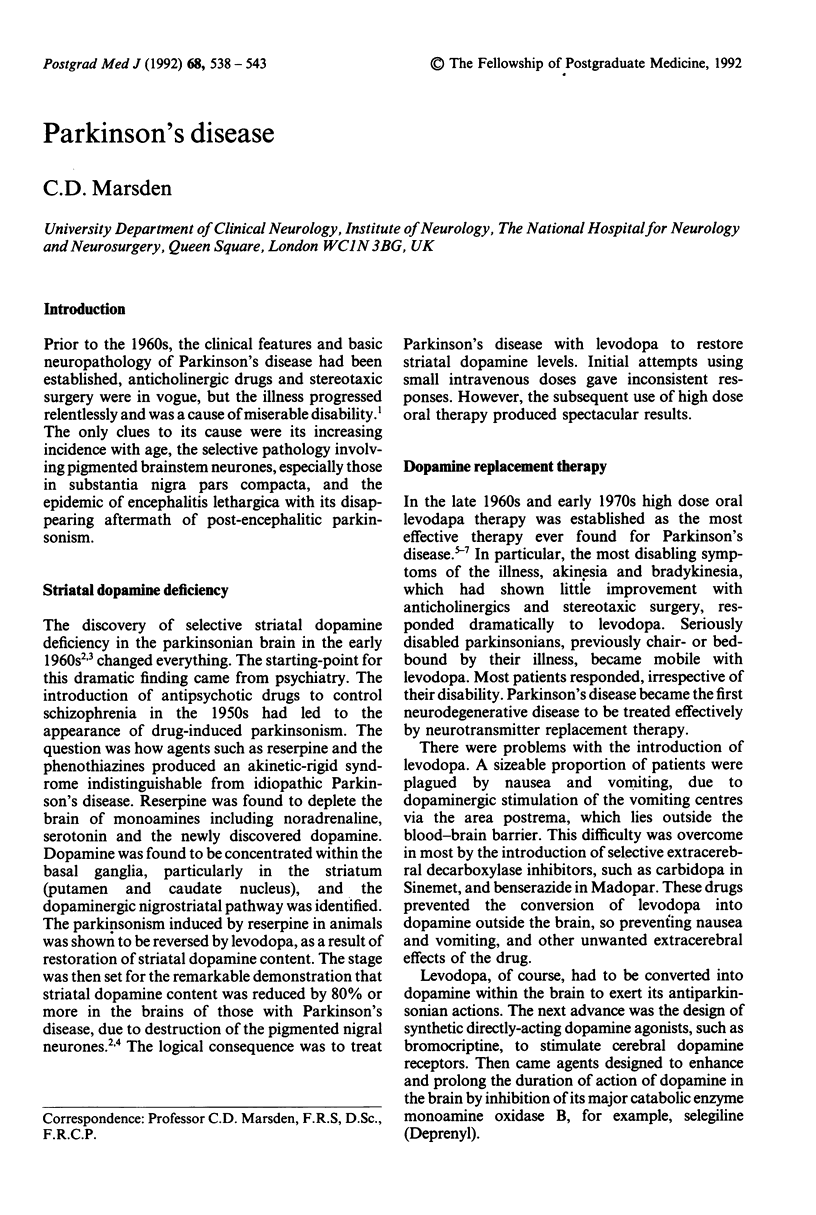
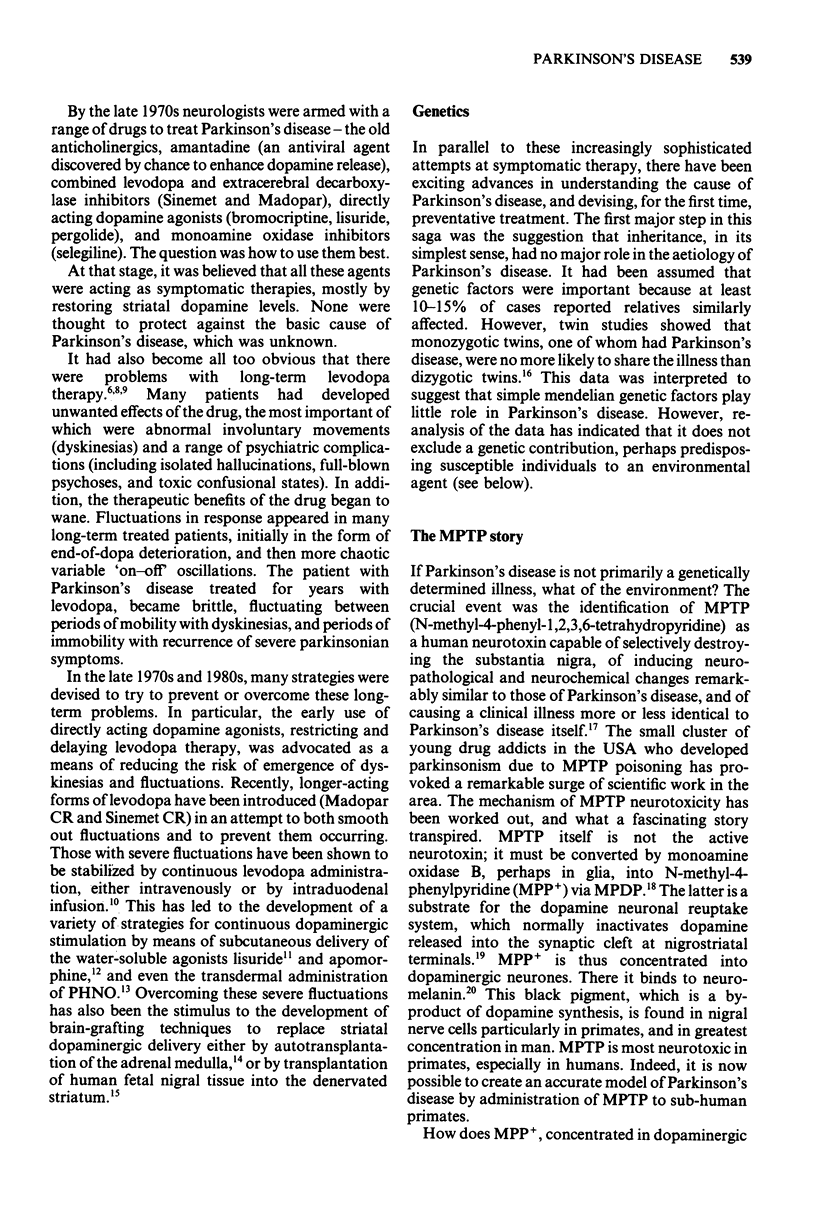
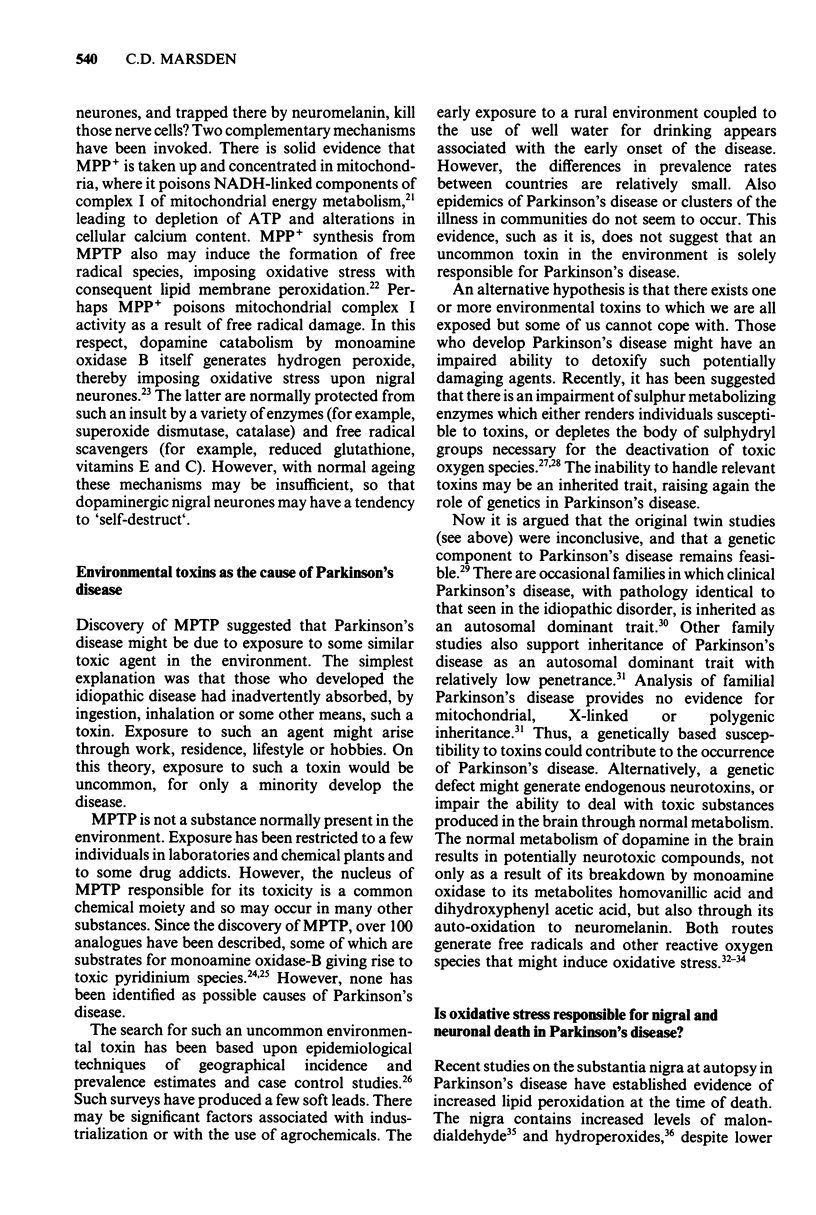
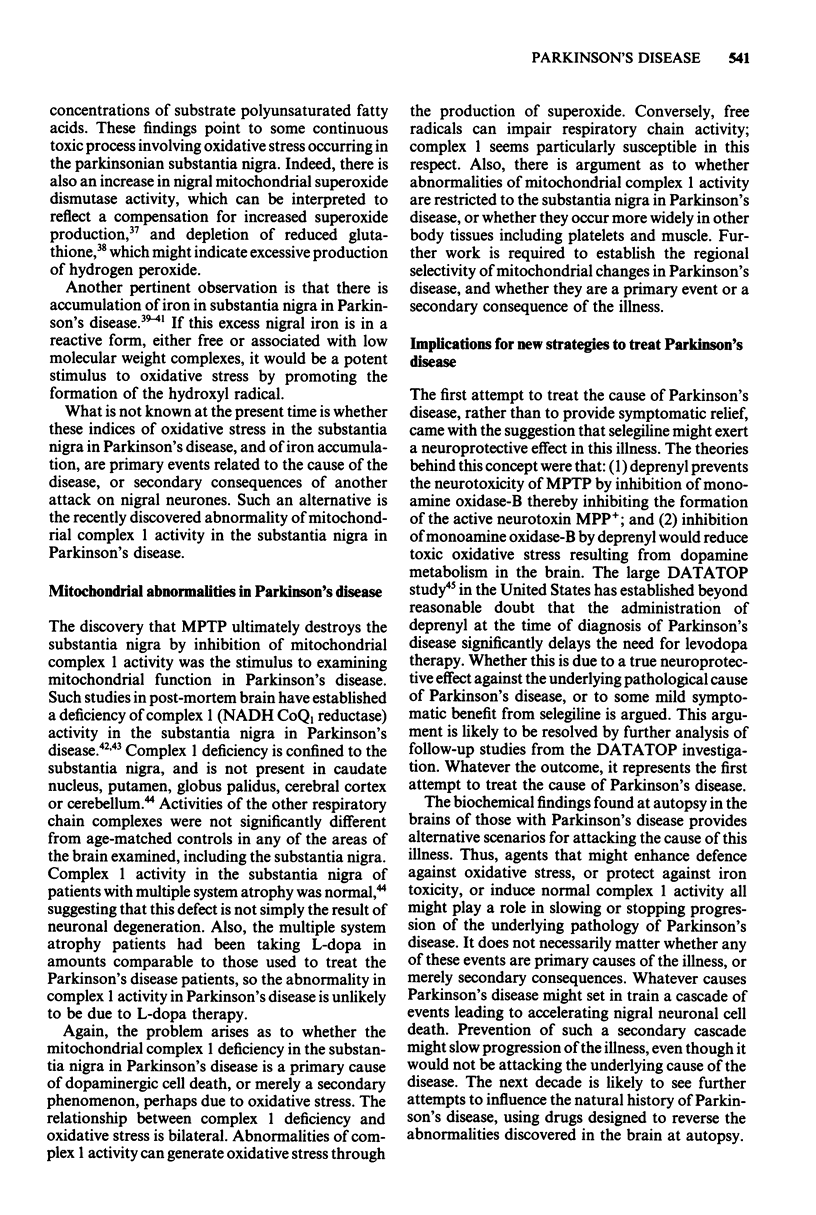
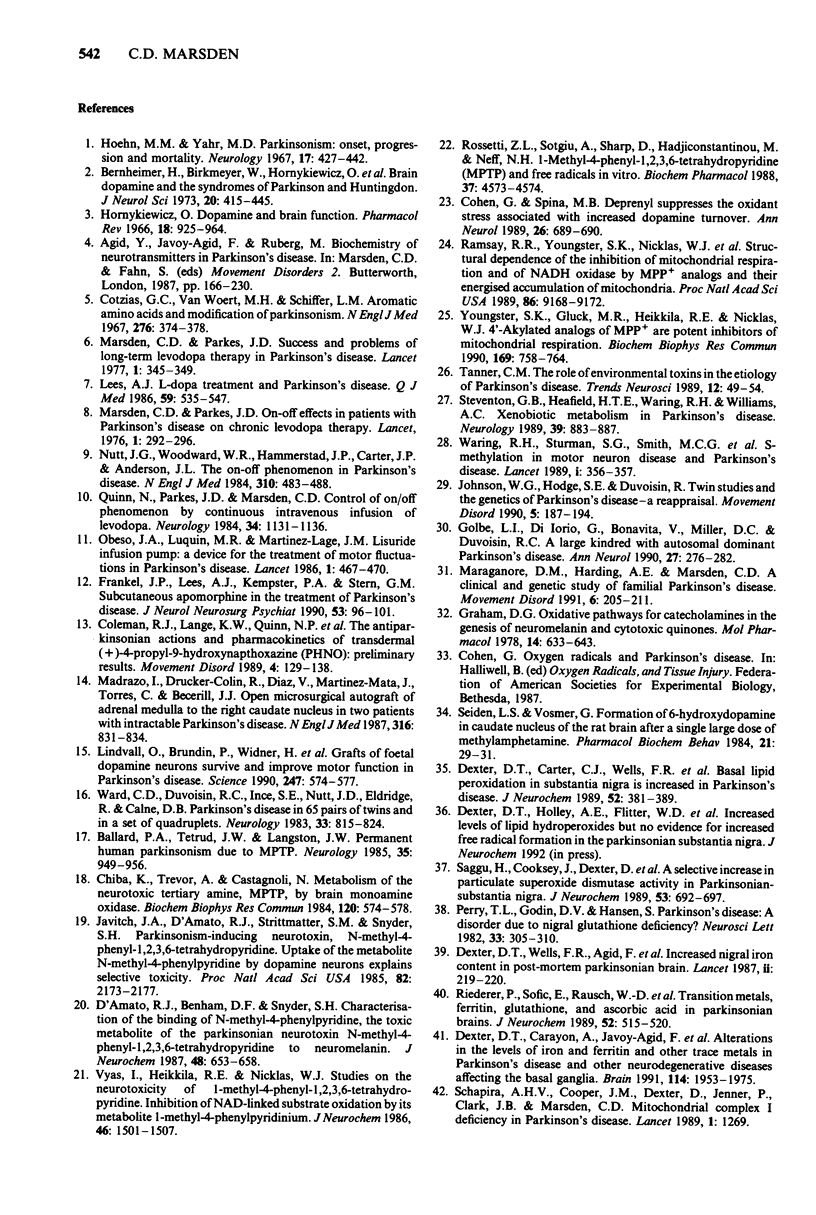

Selected References
These references are in PubMed. This may not be the complete list of references from this article.
- Ballard P. A., Tetrud J. W., Langston J. W. Permanent human parkinsonism due to 1-methyl-4-phenyl-1,2,3,6-tetrahydropyridine (MPTP): seven cases. Neurology. 1985 Jul;35(7):949–956. doi: 10.1212/wnl.35.7.949. [DOI] [PubMed] [Google Scholar]
- Bernheimer H., Birkmayer W., Hornykiewicz O., Jellinger K., Seitelberger F. Brain dopamine and the syndromes of Parkinson and Huntington. Clinical, morphological and neurochemical correlations. J Neurol Sci. 1973 Dec;20(4):415–455. doi: 10.1016/0022-510x(73)90175-5. [DOI] [PubMed] [Google Scholar]
- Chiba K., Trevor A., Castagnoli N., Jr Metabolism of the neurotoxic tertiary amine, MPTP, by brain monoamine oxidase. Biochem Biophys Res Commun. 1984 Apr 30;120(2):574–578. doi: 10.1016/0006-291x(84)91293-2. [DOI] [PubMed] [Google Scholar]
- Cohen G., Spina M. B. Deprenyl suppresses the oxidant stress associated with increased dopamine turnover. Ann Neurol. 1989 Nov;26(5):689–690. doi: 10.1002/ana.410260518. [DOI] [PubMed] [Google Scholar]
- Coleman R. J., Lange K. W., Quinn N. P., Loper A. E., Bondi J. V., Hichens M., Stahl S. M., Marsden C. D. The antiparkinsonian actions and pharmacokinetics of transdermal (+)-4-propyl-9-hydroxynaphthoxazine (+PHNO): preliminary results. Mov Disord. 1989;4(2):129–138. doi: 10.1002/mds.870040204. [DOI] [PubMed] [Google Scholar]
- Cotzias G. C., Van Woert M. H., Schiffer L. M. Aromatic amino acids and modification of parkinsonism. N Engl J Med. 1967 Feb 16;276(7):374–379. doi: 10.1056/NEJM196702162760703. [DOI] [PubMed] [Google Scholar]
- D'Amato R. J., Benham D. F., Snyder S. H. Characterization of the binding of N-methyl-4-phenylpyridine, the toxic metabolite of the parkinsonian neurotoxin N-methyl-4-phenyl-1,2,3,6-tetrahydropyridine, to neuromelanin. J Neurochem. 1987 Feb;48(2):653–658. doi: 10.1111/j.1471-4159.1987.tb04142.x. [DOI] [PubMed] [Google Scholar]
- Dexter D. T., Carayon A., Javoy-Agid F., Agid Y., Wells F. R., Daniel S. E., Lees A. J., Jenner P., Marsden C. D. Alterations in the levels of iron, ferritin and other trace metals in Parkinson's disease and other neurodegenerative diseases affecting the basal ganglia. Brain. 1991 Aug;114(Pt 4):1953–1975. doi: 10.1093/brain/114.4.1953. [DOI] [PubMed] [Google Scholar]
- Dexter D. T., Carter C. J., Wells F. R., Javoy-Agid F., Agid Y., Lees A., Jenner P., Marsden C. D. Basal lipid peroxidation in substantia nigra is increased in Parkinson's disease. J Neurochem. 1989 Feb;52(2):381–389. doi: 10.1111/j.1471-4159.1989.tb09133.x. [DOI] [PubMed] [Google Scholar]
- Frankel J. P., Lees A. J., Kempster P. A., Stern G. M. Subcutaneous apomorphine in the treatment of Parkinson's disease. J Neurol Neurosurg Psychiatry. 1990 Feb;53(2):96–101. doi: 10.1136/jnnp.53.2.96. [DOI] [PMC free article] [PubMed] [Google Scholar]
- Golbe L. I., Di Iorio G., Bonavita V., Miller D. C., Duvoisin R. C. A large kindred with autosomal dominant Parkinson's disease. Ann Neurol. 1990 Mar;27(3):276–282. doi: 10.1002/ana.410270309. [DOI] [PubMed] [Google Scholar]
- Graham D. G. Oxidative pathways for catecholamines in the genesis of neuromelanin and cytotoxic quinones. Mol Pharmacol. 1978 Jul;14(4):633–643. [PubMed] [Google Scholar]
- Hoehn M. M., Yahr M. D. Parkinsonism: onset, progression and mortality. Neurology. 1967 May;17(5):427–442. doi: 10.1212/wnl.17.5.427. [DOI] [PubMed] [Google Scholar]
- Hornykiewicz O. Dopamine (3-hydroxytyramine) and brain function. Pharmacol Rev. 1966 Jun;18(2):925–964. [PubMed] [Google Scholar]
- Javitch J. A., D'Amato R. J., Strittmatter S. M., Snyder S. H. Parkinsonism-inducing neurotoxin, N-methyl-4-phenyl-1,2,3,6 -tetrahydropyridine: uptake of the metabolite N-methyl-4-phenylpyridine by dopamine neurons explains selective toxicity. Proc Natl Acad Sci U S A. 1985 Apr;82(7):2173–2177. doi: 10.1073/pnas.82.7.2173. [DOI] [PMC free article] [PubMed] [Google Scholar]
- Johnson W. G., Hodge S. E., Duvoisin R. Twin studies and the genetics of Parkinson's disease--a reappraisal. Mov Disord. 1990;5(3):187–194. doi: 10.1002/mds.870050302. [DOI] [PubMed] [Google Scholar]
- Lees A. J. L-dopa treatment and Parkinson's disease. Q J Med. 1986 Jun;59(230):535–547. [PubMed] [Google Scholar]
- Lindvall O., Brundin P., Widner H., Rehncrona S., Gustavii B., Frackowiak R., Leenders K. L., Sawle G., Rothwell J. C., Marsden C. D. Grafts of fetal dopamine neurons survive and improve motor function in Parkinson's disease. Science. 1990 Feb 2;247(4942):574–577. doi: 10.1126/science.2105529. [DOI] [PubMed] [Google Scholar]
- Madrazo I., Drucker-Colín R., Díaz V., Martínez-Mata J., Torres C., Becerril J. J. Open microsurgical autograft of adrenal medulla to the right caudate nucleus in two patients with intractable Parkinson's disease. N Engl J Med. 1987 Apr 2;316(14):831–834. doi: 10.1056/NEJM198704023161402. [DOI] [PubMed] [Google Scholar]
- Maraganore D. M., Harding A. E., Marsden C. D. A clinical and genetic study of familial Parkinson's disease. Mov Disord. 1991;6(3):205–211. doi: 10.1002/mds.870060303. [DOI] [PubMed] [Google Scholar]
- Marsden C. D., Parkes J. D. "On-off" effects in patients with Parkinson's disease on chronic levodopa therapy. Lancet. 1976 Feb 7;1(7954):292–296. doi: 10.1016/s0140-6736(76)91416-1. [DOI] [PubMed] [Google Scholar]
- Marsden C. D., Parkes J. D. Success and problems of long-term levodopa therapy in Parkinson's disease. Lancet. 1977 Feb 12;1(8007):345–349. doi: 10.1016/s0140-6736(77)91146-1. [DOI] [PubMed] [Google Scholar]
- Nutt J. G., Woodward W. R., Hammerstad J. P., Carter J. H., Anderson J. L. The "on-off" phenomenon in Parkinson's disease. Relation to levodopa absorption and transport. N Engl J Med. 1984 Feb 23;310(8):483–488. doi: 10.1056/NEJM198402233100802. [DOI] [PubMed] [Google Scholar]
- Obeso J. A., Luquin M. R., Martínez-Lage J. M. Lisuride infusion pump: a device for the treatment of motor fluctuations in Parkinson's disease. Lancet. 1986 Mar 1;1(8479):467–470. doi: 10.1016/s0140-6736(86)92929-6. [DOI] [PubMed] [Google Scholar]
- Perry T. L., Godin D. V., Hansen S. Parkinson's disease: a disorder due to nigral glutathione deficiency? Neurosci Lett. 1982 Dec 13;33(3):305–310. doi: 10.1016/0304-3940(82)90390-1. [DOI] [PubMed] [Google Scholar]
- Quinn N., Parkes J. D., Marsden C. D. Control of on/off phenomenon by continuous intravenous infusion of levodopa. Neurology. 1984 Sep;34(9):1131–1136. doi: 10.1212/wnl.34.9.1131. [DOI] [PubMed] [Google Scholar]
- Ramsay R. R., Youngster S. K., Nicklas W. J., McKeown K. A., Jin Y. Z., Heikkila R. E., Singer T. P. Structural dependence of the inhibition of mitochondrial respiration and of NADH oxidase by 1-methyl-4-phenylpyridinium (MPP+) analogs and their energized accumulation by mitochondria. Proc Natl Acad Sci U S A. 1989 Dec;86(23):9168–9172. doi: 10.1073/pnas.86.23.9168. [DOI] [PMC free article] [PubMed] [Google Scholar]
- Riederer P., Sofic E., Rausch W. D., Schmidt B., Reynolds G. P., Jellinger K., Youdim M. B. Transition metals, ferritin, glutathione, and ascorbic acid in parkinsonian brains. J Neurochem. 1989 Feb;52(2):515–520. doi: 10.1111/j.1471-4159.1989.tb09150.x. [DOI] [PubMed] [Google Scholar]
- Rossetti Z. L., Sotgiu A., Sharp D. E., Hadjiconstantinou M., Neff N. H. 1-Methyl-4-phenyl-1,2,3,6-tetrahydropyridine (MPTP) and free radicals in vitro. Biochem Pharmacol. 1988 Dec 1;37(23):4573–4574. doi: 10.1016/0006-2952(88)90674-0. [DOI] [PubMed] [Google Scholar]
- Saggu H., Cooksey J., Dexter D., Wells F. R., Lees A., Jenner P., Marsden C. D. A selective increase in particulate superoxide dismutase activity in parkinsonian substantia nigra. J Neurochem. 1989 Sep;53(3):692–697. doi: 10.1111/j.1471-4159.1989.tb11759.x. [DOI] [PubMed] [Google Scholar]
- Schapira A. H., Cooper J. M., Dexter D., Clark J. B., Jenner P., Marsden C. D. Mitochondrial complex I deficiency in Parkinson's disease. J Neurochem. 1990 Mar;54(3):823–827. doi: 10.1111/j.1471-4159.1990.tb02325.x. [DOI] [PubMed] [Google Scholar]
- Schapira A. H., Cooper J. M., Dexter D., Jenner P., Clark J. B., Marsden C. D. Mitochondrial complex I deficiency in Parkinson's disease. Lancet. 1989 Jun 3;1(8649):1269–1269. doi: 10.1016/s0140-6736(89)92366-0. [DOI] [PubMed] [Google Scholar]
- Schapira A. H., Mann V. M., Cooper J. M., Dexter D., Daniel S. E., Jenner P., Clark J. B., Marsden C. D. Anatomic and disease specificity of NADH CoQ1 reductase (complex I) deficiency in Parkinson's disease. J Neurochem. 1990 Dec;55(6):2142–2145. doi: 10.1111/j.1471-4159.1990.tb05809.x. [DOI] [PubMed] [Google Scholar]
- Seiden L. S., Vosmer G. Formation of 6-hydroxydopamine in caudate nucleus of the rat brain after a single large dose of methylamphetamine. Pharmacol Biochem Behav. 1984 Jul;21(1):29–31. doi: 10.1016/0091-3057(84)90125-4. [DOI] [PubMed] [Google Scholar]
- Steventon G. B., Heafield M. T., Waring R. H., Williams A. C. Xenobiotic metabolism in Parkinson's disease. Neurology. 1989 Jul;39(7):883–887. doi: 10.1212/wnl.39.7.883. [DOI] [PubMed] [Google Scholar]
- Tanner C. M. The role of environmental toxins in the etiology of Parkinson's disease. Trends Neurosci. 1989 Feb;12(2):49–54. doi: 10.1016/0166-2236(89)90135-5. [DOI] [PubMed] [Google Scholar]
- Vyas I., Heikkila R. E., Nicklas W. J. Studies on the neurotoxicity of 1-methyl-4-phenyl-1,2,3,6-tetrahydropyridine: inhibition of NAD-linked substrate oxidation by its metabolite, 1-methyl-4-phenylpyridinium. J Neurochem. 1986 May;46(5):1501–1507. doi: 10.1111/j.1471-4159.1986.tb01768.x. [DOI] [PubMed] [Google Scholar]
- Ward C. D., Duvoisin R. C., Ince S. E., Nutt J. D., Eldridge R., Calne D. B. Parkinson's disease in 65 pairs of twins and in a set of quadruplets. Neurology. 1983 Jul;33(7):815–824. doi: 10.1212/wnl.33.7.815. [DOI] [PubMed] [Google Scholar]
- Waring R. H., Steventon G. B., Sturman S. G., Heafield M. T., Smith M. C., Williams A. C. S-methylation in motorneuron disease and Parkinson's disease. Lancet. 1989 Aug 12;2(8659):356–357. doi: 10.1016/s0140-6736(89)90538-2. [DOI] [PubMed] [Google Scholar]
- Youngster S. K., Gluck M. R., Heikkila R. E., Nicklas W. J. 4'-alkylated analogs of 1-methyl-4-phenylpyridinium ion are potent inhibitors of mitochondrial respiration. Biochem Biophys Res Commun. 1990 Jun 15;169(2):758–764. doi: 10.1016/0006-291x(90)90396-5. [DOI] [PubMed] [Google Scholar]


